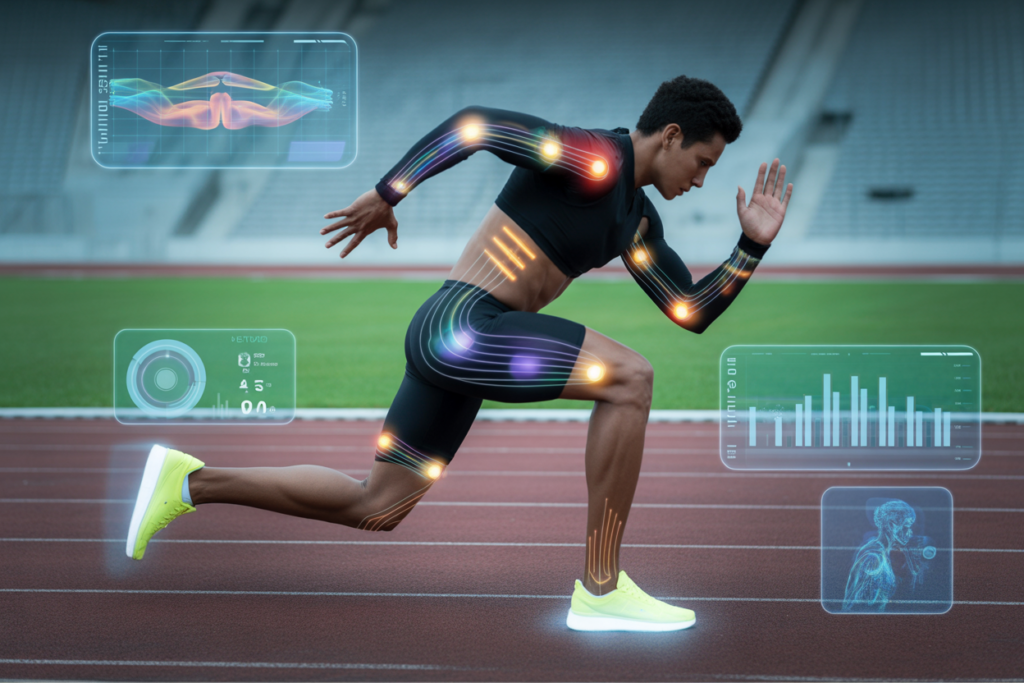Wearable Tech Trends: Revolutionizing Personal Technology
Introduction
Wearable technology has evolved from simple fitness trackers to sophisticated devices that integrate seamlessly into our daily lives, enhancing health, productivity, and connectivity. By October 2025, wearables like smartwatches, fitness bands, smart glasses, and even smart clothing are transforming industries such as healthcare, fitness, fashion, and entertainment. Driven by advancements in sensors, artificial intelligence (AI), 5G connectivity, and miniaturization, the global wearable tech market is projected to reach $186 billion by 2030, according to Statista. This article explores the latest wearable tech trends, their applications, challenges, and the future they promise, while addressing societal and ethical implications.
The Fundamentals of Wearable Technology
What is Wearable Technology?
Wearable technology refers to electronic devices worn on the body, typically equipped with sensors, processors, and connectivity to collect data, provide real-time feedback, or augment user experiences. Common wearables include smartwatches, fitness trackers, augmented reality (AR) glasses, and smart clothing. Key components include:
- Sensors: Measure biometrics like heart rate, motion, or temperature.
- Connectivity: Wi-Fi, Bluetooth, or 5G enable data transfer and cloud integration.
- Processors: Compact chips process data for real-time insights.
- Displays: Touchscreens or micro-LEDs provide user interfaces.
The Evolution of Wearables
Wearable tech began in the 1980s with calculator watches, but the 2010s marked a turning point with devices like the Fitbit and Apple Watch. By 2025, wearables have become more powerful, stylish, and integrated with AI and IoT ecosystems. Advancements in battery life, sensor accuracy, and design have broadened their appeal, making them indispensable tools for modern living.
Major Wearable Tech Trends
1. Advanced Health Monitoring
Wearable devices have become critical tools for health management, offering medical-grade monitoring capabilities. In 2025, the Apple Watch Series 11 introduced non-invasive blood glucose monitoring, a breakthrough for diabetes management. Fitbit’s Sense 3 tracks stress through electrodermal activity and sleep quality with advanced polysomnography sensors. Wearables like Whoop 5.0 use AI to analyze biometric data, providing personalized health recommendations.
Applications:
- Chronic Disease Management: Monitor conditions like diabetes, hypertension, and heart disease in real-time.
- Mental Health: Devices detect stress or anxiety patterns, suggesting mindfulness exercises.
- Preventive Care: Early detection of irregularities, like atrial fibrillation, prompts medical intervention.

2. Smart Glasses and AR Integration
Smart glasses are merging fashion with functionality, offering AR capabilities for work and entertainment. In 2024, Meta’s Orion glasses introduced lightweight AR displays for navigation, gaming, and productivity. Google’s Glass Enterprise 3, launched in 2025, supports hands-free workflows for industries like logistics and healthcare. Snap’s Spectacles 5 enhance social media with AR filters and real-time content sharing.
Applications:
- Navigation: Real-time directions overlaid on the user’s field of view.
- Workplace Efficiency: Technicians use AR glasses to access repair manuals hands-free.
- Social Interaction: AR enhances virtual meetings with holographic avatars.
Case Study: In 2025, a logistics company used Google Glass Enterprise 3 to guide warehouse workers, reducing picking errors by 20% and improving efficiency.
3. Smart Clothing and E-Textiles
Smart clothing integrates sensors and conductive fibers into fabrics, blending technology with fashion. In 2024, Under Armour’s SmartFit apparel monitored muscle activity and posture, aiding athletes in training. Nadi X yoga pants use haptic feedback to guide users through poses. In 2025, Levi’s partnered with Sensoria to create smart jackets with embedded sensors for temperature regulation and gesture control.
Applications:
- Fitness and Sports: Track biomechanics to optimize performance and prevent injuries.
- Healthcare: Smart shirts monitor ECG and respiratory rates for remote patient care.
- Fashion: Interactive clothing changes color or pattern via smartphone apps.

4. Extended Battery Life and Energy Harvesting
Battery life remains a challenge for wearables, but innovations are extending usage times. In 2025, Samsung’s Galaxy Watch 7 achieved a 10-day battery life using low-power processors and optimized software. Energy harvesting technologies, like solar-powered smartwatches from Garmin and kinetic energy systems in Matrix PowerWatch, reduce reliance on charging.
Impact:
- Convenience: Longer battery life supports continuous health monitoring.
- Sustainability: Energy harvesting reduces environmental impact.
- Accessibility: Affordable wearables with extended battery life reach broader markets.
5. 5G and IoT Integration
5G connectivity enhances wearables by enabling real-time data transfer and cloud processing. In 2024, Qualcomm’s Snapdragon W5+ chip supported 5G in wearables, reducing latency for applications like remote surgery and live streaming. IoT integration connects wearables to smart home ecosystems, allowing smartwatches to control lights or thermostats.
Applications:
- Real-Time Health Alerts: 5G enables instant transmission of medical data to doctors.
- Smart Home Control: Wearables act as remote controls for IoT devices.
- Live Streaming: AR glasses stream high-definition content without lag.
6. Brain-Computer Interfaces (BCIs) and Neuro-Wearables
BCIs are an emerging trend, enabling wearables to interact with brain signals. In 2025, Neuralink’s prototype BCI wearable allowed users to control devices with thoughts, targeting accessibility for those with disabilities. Muse’s EEG headbands, enhanced with AI, monitor brain activity to improve focus and meditation.
Applications:
- Accessibility: BCIs enable control for users with mobility impairments.
- Mental Wellness: Neuro-wearables track cognitive health and reduce stress.
- Gaming: BCIs create immersive experiences by responding to neural signals.

Applications of Wearable Technology
1. Healthcare and Wellness
Wearables are revolutionizing healthcare by providing continuous monitoring and personalized insights. In 2025, Fitbit’s Charge 6 detected early signs of heart conditions in 10% of users, prompting timely medical care. Smart patches, like Abbott’s Libre 3, monitor glucose levels non-invasively, improving diabetes management. Wearables also support mental health through guided meditation and stress tracking.
2. Fitness and Sports
Fitness trackers and smart clothing optimize athletic performance. In 2024, Whoop partnered with the NFL to monitor player recovery, reducing injuries by 15%. Smart insoles, like Nurvv Run, analyze gait to improve running efficiency. VR-integrated wearables create immersive fitness experiences, blending exercise with gaming.
3. Workplace Productivity
Wearables enhance efficiency in industries like manufacturing and logistics. In 2025, Amazon deployed smart glasses for warehouse workers, displaying order details and reducing errors by 25%. Wearable exoskeletons, like Ekso Bionics’ EVO, reduce physical strain for factory workers.
4. Entertainment and Social Interaction
Wearables like AR glasses enhance entertainment with immersive experiences. In 2025, Snap’s Spectacles enabled users to share AR-enhanced videos in real-time, boosting social media engagement. VR-integrated wearables support virtual concerts and multiplayer gaming, creating shared digital experiences.
5. Fashion and Lifestyle
Smart clothing and jewelry combine technology with aesthetics. In 2024, Fossil’s smart rings offered discreet notifications and health tracking. Wearable accessories, like Samsung’s Galaxy Ring, appeal to fashion-conscious consumers with customizable designs and biometric monitoring.
Challenges in Wearable Technology
1. Privacy and Data Security
Wearables collect sensitive data, including health metrics and location information. A 2025 data breach in a fitness app exposed user health profiles, raising privacy concerns. Robust encryption and transparent data policies are critical to maintain trust.
2. Battery Life and Form Factor
Despite improvements, battery life limits continuous use, particularly for AR glasses. Bulky designs deter fashion-conscious consumers, requiring further miniaturization. In 2025, 20% of wearable users reported discomfort with heavier devices, according to a Consumer Reports survey.
3. Cost and Accessibility
High-end wearables, like Apple’s Vision Pro ($3,500), remain expensive, limiting adoption. Affordable options are needed to reach developing markets. Installation and maintenance costs for smart clothing also pose barriers.
4. Health and Ethical Concerns
Prolonged wearable use may cause skin irritation or eye strain, particularly with AR glasses. Over-reliance on health wearables could lead to self-diagnosis errors. Ethical concerns include data monetization and potential employer misuse of biometric data.
5. Interoperability
Fragmented ecosystems hinder device compatibility. While standards like Matter improve IoT integration, wearables from different brands often require separate apps, complicating user experiences.
The Future of Wearable Technology
1. Seamless Integration with Daily Life
By 2030, wearables will blend seamlessly into daily routines, becoming as ubiquitous as smartphones. Smart contact lenses, like Mojo Vision’s 2025 prototype, will project AR displays directly onto the retina, eliminating bulky headsets. Wearables will integrate with smart homes, vehicles, and cities for holistic connectivity.
2. Advanced AI and Personalization
AI will enhance wearables with predictive capabilities. Future devices could anticipate health issues, adjust workout plans, or suggest tasks based on user habits. Advanced AI models, like an evolved Grok, will make wearables intuitive personal assistants.
3. Sustainability and Eco-Friendly Designs
Sustainable wearables will use biodegradable materials and energy harvesting. In 2025, Garmin’s solar-powered Instinct 3 extended battery life to 30 days, reducing environmental impact. Recycling programs for wearables will address e-waste concerns.
Prediction: By 2030, wearables will contribute $300 billion to the global economy, with healthcare and fitness as leading sectors, according to PwC.
Societal Implications
Wearable technology has the potential to:
- Enhance Accessibility: Empower people with disabilities through BCIs and AR navigation.
- Drive Economic Growth: Create jobs in wearable design, software development, and healthcare integration.
- Promote Health: Democratize healthcare access with affordable monitoring devices.
However, equitable access and ethical data use are critical to avoid digital divides and privacy violations. Public education and regulation will ensure wearables benefit society responsibly.
Conclusion
Wearable tech trends are reshaping how we monitor health, enhance productivity, and engage with the world. From advanced health trackers to AR glasses and smart clothing, innovations in AI, 5G, and miniaturization are driving adoption. Despite challenges like privacy, cost, and interoperability, the future of wearables is bright, promising seamless integration into daily life. As technology evolves, collaboration between innovators, policymakers, and consumers will ensure wearable tech unlocks its full potential responsibly.


